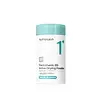What's inside
What's inside
 Key Ingredients
Key Ingredients

 Benefits
Benefits

 Concerns
Concerns

 Ingredients Side-by-side
Ingredients Side-by-side

Silica
AbrasiveDimethicone
EmollientZea Mays Starch
AbsorbentAluminum Starch Octenylsuccinate
AbsorbentVinyl Dimethicone/Methicone Silsesquioxane Crosspolymer
Mica
Cosmetic ColorantDimethicone/Vinyl Dimethicone Crosspolymer
Skin ConditioningCaprylic/Capric Triglyceride
MaskingOctyldodecyl Stearoyl Stearate
EmollientCalamine
AbsorbentPantothenic Acid
Skin ConditioningZinc PCA
HumectantCaprylyl Glycol
EmollientNiacinamide
SmoothingEthylhexylglycerin
Skin ConditioningMacadamia Ternifolia Seed Oil
EmollientCentella Asiatica Extract
CleansingDipotassium Glycyrrhizate
HumectantMadecassoside
AntioxidantTocopherol
AntioxidantSilica, Dimethicone, Zea Mays Starch, Aluminum Starch Octenylsuccinate, Vinyl Dimethicone/Methicone Silsesquioxane Crosspolymer, Mica, Dimethicone/Vinyl Dimethicone Crosspolymer, Caprylic/Capric Triglyceride, Octyldodecyl Stearoyl Stearate, Calamine, Pantothenic Acid, Zinc PCA, Caprylyl Glycol, Niacinamide, Ethylhexylglycerin, Macadamia Ternifolia Seed Oil, Centella Asiatica Extract, Dipotassium Glycyrrhizate, Madecassoside, Tocopherol
Distarch Phosphate
AbsorbentSilica
AbrasiveZinc Oxide
Cosmetic ColorantNiacinamide
SmoothingPantothenic Acid
Skin ConditioningMaltodextrin
AbsorbentAllantoin
Skin ConditioningPueraria Lobata Root Extract
HumectantDipotassium Glycyrrhizate
HumectantPiper Methysticum Root Extract
Skin ConditioningMadecassoside
AntioxidantAsiaticoside
AntioxidantHydroxypropyl Cyclodextrin
MaskingSalix Alba Bark Extract
AstringentPunica Granatum Pericarp Extract
Skin ConditioningWater
Skin ConditioningDextrin
AbsorbentDistarch Phosphate, Silica, Zinc Oxide, Niacinamide, Pantothenic Acid, Maltodextrin, Allantoin, Pueraria Lobata Root Extract, Dipotassium Glycyrrhizate, Piper Methysticum Root Extract, Madecassoside, Asiaticoside, Hydroxypropyl Cyclodextrin, Salix Alba Bark Extract, Punica Granatum Pericarp Extract, Water, Dextrin
 Reviews
Reviews

Ingredients Explained
These ingredients are found in both products.
Ingredients higher up in an ingredient list are typically present in a larger amount.
Dipotassium Glycyrrhizate comes from licorice root.
Extracts of licorice have demonstrated to have antibacterial, anti‐inflammatory, antiviral, antioxidant properties.
One component, glabridin, has extra potent antioxidant and soothing properties. It has also been found to block pigmentation from UVB rays in guinea pigs.
Licorice Root also contains a flavonoid. Flavonoids are a natural substance from in plants. Flavonoids also have antioxidant properties.
Another component, glycyrrhizin, has been found to have anti-inflammatory and antimicrobial benefits. This may make licorice root extract effective at treating acne. However, more research is needed to support this.
Liquiritin is one of the flavone compounds found in licorice. It has been found to help lighten skin by preventing tyrosinase from reacting with tyrosine. When the two react, protein is converted to melanin. Melanin is the substance in your body that gives your features pigmentation.
Licorice root is native to Southern Europe and Asia. It has been used in traditional Chinese medicine to help with respiratory issues.
Learn more about Dipotassium GlycyrrhizateMadecassoside comes from the super popular skin-soothing ingredient, Centella asiatica. It is one of four active compounds found in the extract of Centella Asiatica.
Madecassoside has antioxidant, anti-inflammatory, and hydrating properties. It contains fatty acids, amino acids, beta-carotene, and phytochemicals.
One study found using Madecassoside with ascorbic acid helped reduce the signs of aging and improved skin hydration.
Learn more about MadecassosideNiacinamide is a multitasking form of vitamin B3 that strengthens the skin barrier, reduces pores and dark spots, regulates oil, and improves signs of aging.
And the best part? It's gentle and well-tolerated by most skin types, including sensitive and reactive skin.
You might have heard of "niacin flush", or the reddening of skin that causes itchiness. Niacinamide has not been found to cause this.
In very rare cases, some individuals may not be able to tolerate niacinamide at all or experience an allergic reaction to it.
If you are experiencing flaking, irritation, and dryness with this ingredient, be sure to double check all your products as this ingredient can be found in all categories of skincare.
When incorporating niacinamide into your routine, look out for concentration amounts. Typically, 5% niacinamide provides benefits such as fading dark spots. However, if you have sensitive skin, it is better to begin with a smaller concentration.
When you apply niacinamide to your skin, your body converts it into nicotinamide adenine dinucleotide (NAD). NAD is an essential coenzyme that is already found in your cells as "fuel" and powers countless biological processes.
In your skin, NAD helps repair cell damage, produce new healthy cells, support collagen production, strengthen the skin barrier, and fight environmental stressors (like UV and pollution).
Our natural NAD levels start to decline with age, leading to slower skin repair, visible aging, and a weaker skin barrier. By providing your skin niacinamide, you're recharging your skin's NAD levels. This leads to stronger, healthier, and younger looking skin.
Another name for vitamin B3 is nicotinamide. This vitamin is water-soluble and our bodies don't store it. We obtain Vitamin B3 from either food or skincare. Meat, fish, wheat, yeast, and leafy greens contain vitamin B3.
The type of niacinamide used in skincare is synthetically created.
Learn more about NiacinamidePantothenic Acid is an essential vitamin. Our bodies use it for metabolizing fatty acids, proteins, carbohydrates, and fats.
Silica, also known as silicon dioxide, is a naturally occurring mineral. It is used as a fine, spherical, and porous powder in cosmetics.
Though it has exfoliant properties, the function of silica varies depending on the product.
The unique structure of silica enhances the spreadability and adds smoothness, making it a great texture enhancer.
It is also used as an active carrier, emulsifier, and mattifier due to its ability to absorb excess oil.
In some products, tiny microneedles called spicules are made from silica or hydrolyzed sponge. When you rub them in, they lightly polish away dead skin layers and enhance the penetration of active ingredients.
Learn more about Silica